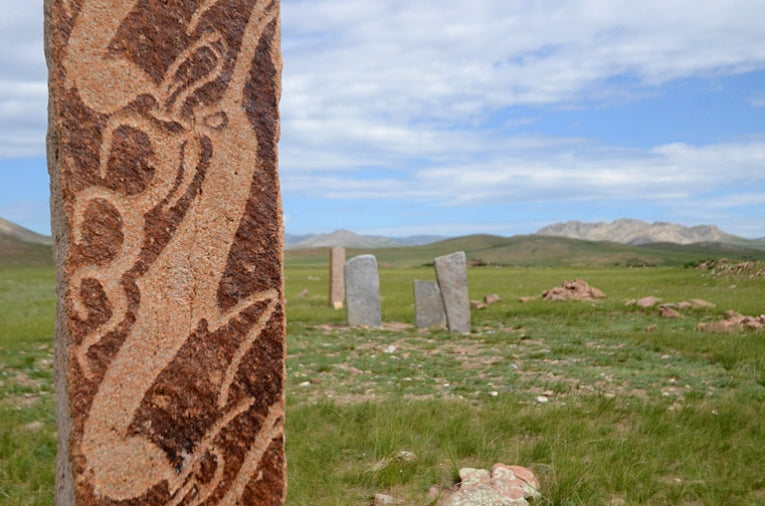Image: A stone monument on the Mongolian steppe celebrating deer, dated from the Mid-Bronze Age
Mongolia, the little-known land sandwiched between China to the south and Siberia to the North is what one expert calls, "a laboratory for climate change". The lightly-populated steppes, home to a herding culture, are a pristine environment, mostly little-affected by man for generations.
In a country the size of Western Europe, 750,000 peoples' lives depend on their cattle herds. Unlike many other places, which have had huge inputs from human development which complicate the picture, Mongolia can be seen as somewhere that the impact of global climate instability can be observed clearly, especially as the climate there seems to be changing more rapidly than many other places on the globe.

Photo: Dr. Clyde Goulden interviewing traditional herdsman Baatar and his family in Sevsuul Valley, Lake Hovsgol
Dr. Clyde Goulden, Director of the Asia Center of the Academy of Natural Sciences of Philadelphia, has been going to Mongolia since 1994, when he was invited by a Buddhist Lama who was worried about the Mongolian ecosystem. Since then, Dr Goulden has been studying the area around Lake Hovsgol - a huge, deep water basin which is similar in its ecology to Lake Baikal in Siberia. Goulden's first task was to train 18 young Mongolian scientists to assist his team in their studies. Some have progressed to working on their PhDs and studying at foreign universities.
 <
<
Photo: Herdsman Baga and family in Mongolian dress
The Mongolian people are primarily nomadic, living in gers (we might call them yurts, but this is incorrect, being the Russian word) and moving around with their herds of sheep and goats. It is a tough life, but in order to survive, people need to be in touch with the natural world much more than urban dwellers, and the climate, particularly in winter, has a big effect on where they move their herds to, and of course, harsh winters can be difficult to survive. Records show there has been a dramatic warming of over 2 degrees Celsius during the past 70 years in Mongolia. The ground is drier, grass is not growing as richly, rivers and streams are drying up. Dr Goulden suggested that the most plausible explanation for this phenomenon is that the warming temperature has reduced the snow in winter and that has produced a feedback effect - less snow to reflect the sun means more warming means more snow melting, and the temperature continues to climb.

Photo: Hovsgol climate change experiment with Boldgiv - Mongolian researcher from their National University - setting up "open top chambers". These are experiments by Dr. Brenda Casper, University of Pennsylvania designed to warm steppe areas for study of impact on plants of continued warming
Dr Goulden has interviewed around 100 herders, and nearly all of them say that the weather has become more unpredictable, the rains have become more intense - instead of sinking in, they run off and so the soil becomes dryer, and the winds have become stronger. In a chaotic weather system, these sort of effects can be expected: while there is a general warming trend, there are wide variations, which cause major ecosystem disruptions. Dr Goulden's team are continuing experiments to clarify the extent of the problem. He says, "In our own cities, the storm run-off systems are not geared to intense, heavy rains. Unless we prepare, we are going to have difficulty in adapting to climate change." Dr Goulden is planning a visit to Asia in September to continue his work and studies.


Photos: (Left) An Ovo, a pile of rocks accumulated by numerous travellers at the high-point of a road. Each traveller supposedly adds a stone to the pile that he or she brought from the valley and then circles the ovo clock-wise three times to bless the next part of the trip. The blue ribbons are a "Hadag", Buddhist sacred symbols that they often pray with. (Right) Young boys (8-12 yo) nearing the finish line during a horse race.
Aside from the humanitarian disaster if harsher winters cause starvation amongst the Mongolian herders, the larger picture indicates that Western nations need to speed up their policies for both emissions reduction and adaptation to climate change, to avoid the worst effects of an unstable climate.
All photos copyright Daniel Grossman 2011.
Links:
Asia Center at The Academy of Natural Sciences
American Center for Mongolian Studies










